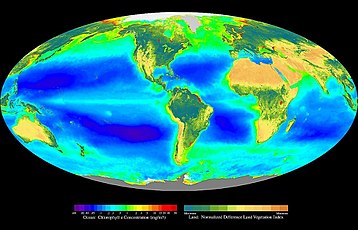
Back إنتاج أولي Arabic Producció primària Catalan Nettoprimærproduktion Danish Primärproduktion German Producción primaria Spanish Primaarproduktsioon Estonian Ekoizpen primario Basque تولید اولیه Persian Perustuotanto (biologia) Finnish Production primaire French

In ecology, primary production is the synthesis of organic compounds from atmospheric or aqueous carbon dioxide. It principally occurs through the process of photosynthesis, which uses light as its source of energy, but it also occurs through chemosynthesis, which uses the oxidation or reduction of inorganic chemical compounds as its source of energy. Almost all life on Earth relies directly or indirectly on primary production. The organisms responsible for primary production are known as primary producers or autotrophs, and form the base of the food chain. In terrestrial ecoregions, these are mainly plants, while in aquatic ecoregions algae predominate in this role. Ecologists distinguish primary production as either net or gross, the former accounting for losses to processes such as cellular respiration, the latter not.
© MMXXIII Rich X Search. We shall prevail. All rights reserved. Rich X Search